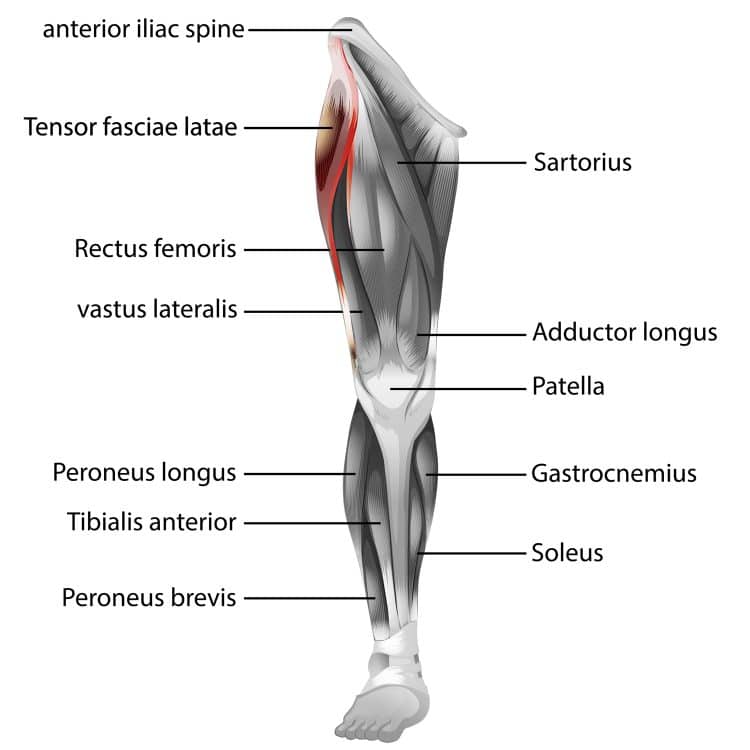If you are an average lifter, chances are this is the first time you’re learning about the tensor fasciae latae (TFL). Furthermore, you might not even realize you have a tight TFL muscle until a visit to a physiotherapist.
We’ll go as far as to say that you’re leaving gains on the table if you train regularly but do not have tensor fasciae latae stretches in your routine.
Tensor fasciae latae is latin for tense band side. It describes the function and location of the muscle. The TFL tenses the iliotibial (IT) band at the side of your body.
The TFL is a thigh muscle that helps maintain pelvic balance while standing, walking, or running. It acts on the iliotibial band along with the gluteus maximus and is continuous with the iliotibial tract, which attaches to the tibia, also known as the shinbone or shank bone. The TFL is right behind where the coin pocket of a regular pair of jeans would be.
The tensor fasciae latae tautens the iliotibial tract and braces the knee, especially when the opposite foot is lifted. [1]
Due to the size and location of the tensor fasciae latae, it tends to tense up easily, which can hamper your mobility, balance, and functionality. While lower body-focused compound movements are great for building overall leg strength and muscle mass, they do little for the TFL.
Level Up Your Fitness: Join our 💪 strong community in Fitness Volt Newsletter. Get daily inspiration, expert-backed workouts, nutrition tips, the latest in strength sports, and the support you need to reach your goals. Subscribe for free!
Tensor Fasciae Latae Functions
Given below are the functions of the TFL:
1. Helps Maintain Balance
This is the primary function of the TFL. It helps maintain pelvic balance while standing, walking, or running. Plus, it is utilized in horse riding, hurdling, and water skiing.
The gluteal muscles — medius, maximus, and minimus — work together with the TFL for hip flexion, hip abduction, and internal rotation. Weak TFL muscles can force the glute muscles to fill in and cause strength and muscle imbalances. On the other hand, weak glutes might force the TFL to compensate.
2. Improves Posture
Due to its position on your upper thigh, the TFL plays a role in maintaining pelvic stability, balance, and a good posture. Plus, since the TFL is attached to the IT band, which is, in turn, joined to the tibia, it aids in knee flexion and lateral rotation.
3. Boosts Functionality
Regularly stretching the TFL can help improve your mobility and functionality as it is considered a secondary hip flexor. A tight or overused TFL muscle can cause an irritated or swollen IT band, known as ITB syndrome. The condition gets worse with more movement.
Due to its insertion point on the tibia, it also aids in its lateral rotation.
4. Prevents Injuries
As discussed above, weak TFL or gluteal muscles can cause muscle and strength imbalances, increasing the risk of injury. Adding tensor fascia latae stretches and exercises into your training regimen can help reduce the odds of injury in and outside the gym.
A few problems that arise due to a tight or shortened TFL muscle include pelvic imbalances that lead to hip pain and pain in the lower back and lateral area of the knees.
Causes of a Tight Tensor Fasciae Latae
Tight TFL muscles can be a result of several factors, including:
- Overuse
- Compensating for weak gluteal muscles
- Weak hip flexors
- Weak hip abductors
- Poor posture
- Standing with your weight shifted onto one leg
- Prolonged sitting
Signs of a Stiff Tensor Fasciae Latae
Before we get into why you need to stretch the TFL and the best exercises, let’s discover if you have stiff tensor fasciae latae muscles. Here are the most common signs of a tense TFL:
- Anterior pelvic tilt
- Poor posture
- Back pain
- Hip pain or instability
- Limited range of motion
If you are dealing with any of these issues, you should stop resisting and start working on loosening up the faulty muscles.
Test To Determine a Tight Tensor Fasciae Latae
Here are some of the most popular tests to corroborate a tight TFL:
1. Thomas Test
The Thomas test is a simple TFL test you can perform on yourself. It was developed by Dr. Hugh Owen Thomas in the 1800s and is used to measure the flexibility of the hip flexors and rule out psoas syndrome and hip flexion contracture.
Level Up Your Fitness: Join our 💪 strong community in Fitness Volt Newsletter. Get daily inspiration, expert-backed workouts, nutrition tips, the latest in strength sports, and the support you need to reach your goals. Subscribe for free!
Steps:
- Lie supine on an elevated bench so your glutes are at its edge.
- Bring both knees to your chest by bending at your hips and knees.
- Keep the unaffected leg flexed and grab the knee of that side with both hands.
- Slowly lower the affected leg as far as possible toward the floor.
- Take note of how far the extended leg stretches.
- Repeat on the other side.
Result: You have a tight TFL if your extended leg pushes out to the side instead of going straight down under you.
2. Ober’s Test
Created by Frank Ober, his namesake test first appeared in an article in the Journal of Bone and Joint Surgery in 1935. This test assesses a tight, contracted, or inflamed TFL and ITB. Notably, this test requires a trained practitioner.
Steps:
- The patient should be lying on their side with the affected side up.
- Flex the bottom knee and hip to flatten the lumbar curve.
- Stand behind the patient and firmly stabilize the pelvis/greater trochanter to prevent movement in any direction by pressing on their side.
- Grab the knee of the patient’s affected leg with your other hand and flex the leg to a right angle at the knee.
- Extend and abduct the hip joint.
Result: The patient has a tight TFL if their upper knee can’t be lowered past the body’s midline.
3. Modified Ober’s Test
The modified Ober’s test puts less strain on the medial aspect of the knee joint, less tension on the patella, less interference by a tight rectus femoris, and provides a complete TFL stretch.
Steps:
- The patient is in a side-lying position with his lower leg flexed at the hip and knee to flatten the low back.
- The examiner presses on the pelvis and trunk to keep them in contact with the table.
- Grab the knee of the patient’s affected leg with your other hand and flex the leg to a right angle at the knee.
- While holding this position, the examiner laterally tilts the knee.
Result: The examinee has a tight TFL if their affected leg doesn’t drop to around 10 degrees below the midline.
Why Stretch the Tensor Fasciae Latae?
Whether you’re a highly active individual who trains six days a week or a non-exerciser that spends eight-plus hours in front of a computer screen each day, you need to add stretching to your routine. It can ensure optimal mobility and functionality and reduce the risk of developing muscle and strength imbalances, which can cause injuries.
You could use dynamic, static, or ballistic stretches to loosen up your TFL muscle. Experts also recommend incorporating self-myofascial massage into your TFL stretching routine for better muscle stimulation.
The tensor fasciae latae is a hip abductor muscle, meaning you’ll have to bring the knee medially across the body (adduction) to achieve an optimal stretch in the muscle.
10 Best Tensor Fasciae Latae Stretches
Given below are the best TFL stretches that should be a part of your training regimen:
1. Standing TFL Stretch
Steps:
- Stand upright with a shoulder-wide stance.
- Stand near a wall for support if you are a beginner and have never tried this exercise.
- Cross your right leg behind your left.
- Push your hips forward and to the same side as your rear leg.
- Hold this position for 30-60 seconds.
- Alternate between sides for recommended reps.
2. Iron Cross Stretch
Steps:
- Lie supine on an exercise mat.
- Place your arms on the floor at your sides so they are perpendicular to your torso.
- Lift your left leg towards the ceiling until it is perpendicular to the floor while keeping the right leg planted on the ground.
- Without moving your torso, place the left leg on the opposite side of your body so it is parallel to the right arm.
- Hold this position for 30-60 seconds.
- Raise your left leg towards the ceiling and return to the starting position.
- Repeat with the right leg.
- Alternate between sides for recommended reps.
3. Seated Half Spinal Twist
Steps:
- Sit up on an exercise mat with your hands on the floor behind you for support.
- Straighten your legs out in front of you.
- Bend your right knee and place your right foot on the outside of your left knee.
- Twist toward your right while placing your left upper arm on the outside of your right leg near the knee.
- Hold the position for 30-60 seconds while focusing on stretching the TFL.
- Return to the starting position.
- Repeat on the other side.
- Alternate between sides for recommended reps.
4. Lying Abductor Stretch
Steps:
- Lie supine on an exercise mat with your arms extended at your sides.
- Lift your right leg off the floor and bend at your knee so that your upper leg is perpendicular to the floor and the lower leg is parallel.
- Lower your right leg across your body so your upper leg is parallel to the floor.
- Hold this position for 30-60 seconds.
- Repeat for recommended reps before switching sides.
5. Lying Leg Hanging Stretch
Steps:
- Lie down on a bench on your right side.
- Place your right hand under your head for support.
- Lower your left leg over the side of the bench toward the floor.
- Hold this position for 30-60 seconds.
- Repeat for recommended reps before switching sides.
6. Leaning Abductor Stretch
Steps:
- Stand upright close to a wall with your feet placed together.
- Place your hand on the wall for support.
- Lean your weight towards your outer hip while focusing on your TFL.
- Hold this position for 30-60 seconds.
- Repeat for recommended reps before switching sides.
7. Hip Circles Stretch
Steps:
- Stand upright with your feet hip-width apart.
- Place your hands on your hips.
- Slowly move your hips in a circular motion completing full circles.
- Repeat for desired reps before switching directions.
- Complete 3 sets of 10 reps in each direction.
8. Quadruped Active TFL Stretch
Steps:
- Assume a tabletop position with your hands stacked under your shoulders and knees under the hips.
- Extend one leg behind you by contracting the glutes until the leg is parallel to the floor.
- Externally rotate the hip pointing your toes out at 45 degrees.
- Adduct the hip while keeping a neutral spine.
- Hold for up to 30 seconds.
- Repeat for recommended reps before switching sides.
9. TFL Foam Roller Stretch
Steps:
- Locate the TFL which is in the front corner space between the iliac crest and the greater trochanter of the femur.
- Place a foam roller on the ground.
- Lie down on your left side with the roller on your TFL.
- Place your left forearm on the floor and your right hand on the floor to balance yourself.
- You can also bend your right leg and place your foot on the floor on your side for more support.
- Roll up and down on the pain points for 30-60 seconds.
- Repeat 2-3 times before switching sides.
10. Standing Balance Outer Hip Stretch
Steps:
- Stand upright with your feet hip-width apart.
- Lift your right leg off the floor until the upper leg is parallel to the floor.
- Grab your right lower leg with both hands. Alternatively, you could hold your leg with one hand and use the other hand to hold a sturdy object for support.
- Slowly lean towards the side of your lifted leg to stretch the TFL.
- Hold for 15-30 seconds.
- Switch sides.
- Alternate between sides for recommended reps.
5 Exercises To Strengthen TFL
Although the 10 exercises mentioned above are great for releasing TFL tension, the tensor fasciae latae gets stronger only when you train the surrounding muscles. Strengthen the TFL by adding the following exercises into your training regimen:
1. Fire Hydrant
Steps:
- Get into a tabletop position with your knees under your hips and your hands under your shoulders.
- Brace your core and make sure your spine is neutral, i.e., your lower back is slightly arched.
- Keeping your knee and hip bent to 90 degrees, lift one leg up and out to the side. Keep the rest of your body stationary.
- Raise your leg to about 45 degrees. Make sure your knee and hip remain aligned.
- Pause with your leg raised for 5-10 seconds.
- Slowly return to the starting position.
- Repeat for the desired number of reps and then swap legs.
Check out our complete fire hydrant guide here!
2. Donkey Kickback
Steps:
- Get into a quadruped position so your shoulders are directly over your hands and your hips are over your knees.
- Extending your hip, and keeping your knee bent, lift one leg out and behind you, pushing your heel up toward the ceiling.
- Hold the position for 5-10 seconds.
- Return to the starting position.
- Repeat for recommended reps before switching sides.
Check out our complete donkey kickback guide here!
3. Lateral Band Walk
Steps:
- Wrap a resistance band above each ankle and around both legs.
- Position your feet shoulder-width apart. The band should be taut, but not stretched.
- Bend your knees slightly and move into a half-squat position.
- Maintaining the half-squat position, shift your weight over one leg and take a step sideways with the other leg.
- Walk sideways for eight to 10 repetitions.
- Switch sides.
4. Clamshell
Steps:
- Lie on your side with your legs stacked and knees bent at a 45-degree angle.
- Rest your head on your lower arm, and use your top arm to steady your frame.
- Brace your core. It will also help stabilize your spine and pelvis.
- Keeping your feet touching, raise your upper knee as high as possible without shifting your hips or pelvis. Don’t move your lower leg off the floor.
- Pause at the top for 5-10 seconds.
- Return your upper leg to the starting position.
- Do 20 reps before switching sides.
5. Single-Leg Glute Bridge
Steps:
- Lie supine on an exercise mat with your hands by your sides, knees bent, and feet flat on the floor.
- Lift one foot off the floor, extending the leg fully so it is roughly 45 degrees to the floor. This is the starting position.
- Raise your hips off the floor by contracting your core and glutes and driving your heel into the floor.
- Your shoulders and knees should be in a straight line at the top.
- Hold this position for 5-10 seconds.
- Slowly return to the starting position.
- Repeat on the same leg for the desired reps before switching sides.
Check out our complete single-leg glute bridge guide here!
A Step-by-Step Guide To Treating TFL Pain
Use the following steps to relieve TFL pain:
1. RICE
RICE (rest, ice, compression, and elevation) is a tried-and-true self-care technique that helps reduce swelling, ease pain, and speed up healing. It includes:
- Rest: After you’ve diagnosed a TFL sprain, do not engage in lower body workouts and rest for at least the first two days.
- Ice: Icing a TFL sprain can help reduce swelling and ease the pain. Apply an ice pack for 15-20 minutes every two to three hours during the first 24 to 48 hours after your injury.
- Compression: Wrapping the affected area can reduce swelling and ease the pain.
- Elevation: Sleeping with a pillow between your legs can help ease TFL pain.
2. Stretching
Stretching will not only help prevent injuries, but it can also play a vital role in rehabilitation. Use the stretching exercises mentioned in this article to stretch your TFL after training or long hours on your desk.
3. Strengthening
Performing the strength exercises mentioned in this article can help improve your balance and posture and prevent injuries.
4. Self Myofascial Release
SMR techniques involve tools like foam rollers to massage muscles and the fascia around them, which helps relieve pain and tightness.
Frequently Asked Questions
How long does a weak TFL muscle take to repair?
It depends on your lifestyle. However, people with TFL sprains usually require a recovery time of 1-3 weeks. On the other hand, TFL tears take much longer, usually 4-6 weeks or more.
Can you train with an injured TFL?
While you can train with a TFL injury, you should avoid it as it can aggravate the situation. You should stop all training for at least two days after sustaining any injury. Return to your normal training routine after the injury has healed.
Should I do the TFL stretches if I don't have weak TFL muscles?
Yes. Adding the TFL stretches to your regimen will ensure strong and flexible TFL. These supporting muscles can also help improve overall functionality.
Wrapping Up
The tensor fasciae latae is a small and powerful muscle that helps us maintain our posture and balance and perform basic activities like walking and running. However, the TFL is often overused, leading to stiffness and chronic pain.
Regularly stretching and massaging the tensor fasciae latae are the most effective ways of keeping the muscle in an optimal condition and avoiding the chances of injury.
References
- Trammell AP, Nahian A, Pilson H. Anatomy, Bony Pelvis, and Lower Limb, Tensor Fasciae Latae Muscle. [Updated 2022 Aug 8]. In: StatPearls [Internet]. Treasure Island (FL): StatPearls Publishing; 2022 Jan-.










